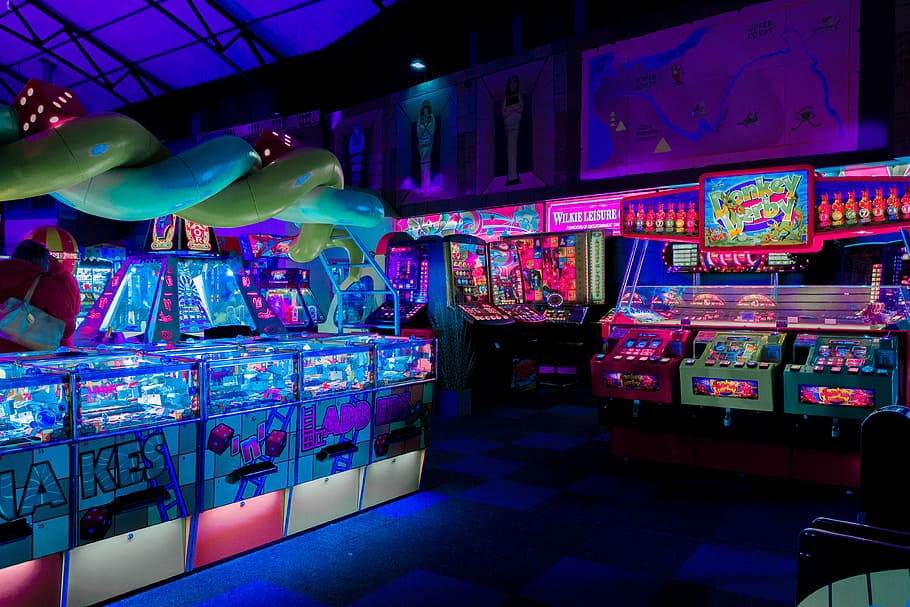Arcade games have long captivated audiences, transporting players into vibrant worlds filled with challenge and excitement. From the pixelated beginnings in the 1970s to today’s immersive experiences, the evolution of arcade games showcases incredible technological advancements and cultural shifts. This journey not only highlights beloved classics but also unveils the genres that have defined and shaped the gaming landscape.
As we delve deeper, we will explore the various genres that encompass arcade games, such as platformers, shooters, and puzzle games. Each genre offers unique mechanics and gameplay styles, while the rise of multiplayer features has transformed how players engage and connect within these digital realms.
Evolution of Arcade Games

The journey of arcade games has been a fascinating evolution from simple electronic amusements to the intricate, immersive experiences we enjoy today. Originating in the early 1970s, arcade games have not only transformed technologically but have also significantly influenced popular culture over the decades. This timeline reflects the changes in gaming technology, design, and cultural significance, illustrating how arcade games have captured the imagination of players worldwide.
The inception of arcade games began with the release of “Computer Space” in 1971, followed by the landmark game “Pong” in 1972, which popularized video gaming in public spaces. The late 1970s and early 1980s marked a golden era for arcade games as titles like “Space Invaders,” “Pac-Man,” and “Donkey Kong” dominated the scene, leading to a surge in arcade cabinets in malls and entertainment venues. The technological advancements during this period, such as improved graphics and sound capabilities, played a crucial role in enhancing the gaming experience.
Technological Advancements in Arcade Gaming
Several key technological advancements have shaped the arcade gaming experience over the years. These innovations have not only improved the gameplay but also influenced the aesthetics and interactivity of arcade games.
- Microprocessor Development: The introduction of microprocessors allowed for more complex game mechanics and better graphics. This shift was evident in games like “Galaga” (1981), which featured more intricate enemy patterns and animations.
- Raster Graphics: The move from vector graphics to raster graphics in the late 1970s enabled more detailed and colorful visuals, enhancing player engagement through games like “Pac-Man” (1980) that utilized vibrant sprites.
- Sound Technology: Advancements in sound technology, including the use of synthesized audio and digital sound effects, created an immersive atmosphere, as heard in “Street Fighter II” (1991), which featured unique character voices and sound effects.
- Networked Play: The introduction of networked arcade games in the 1990s allowed players to compete against each other, transforming the arcade from a solitary experience to a social hub, exemplified by “Dance Dance Revolution” (1998).
Cultural Impact of Arcade Games in the 1980s and 1990s
The cultural impact of arcade games during the 1980s and 1990s was profound, shaping not only the gaming industry but also the broader entertainment landscape. Arcades became social gathering places for people of all ages, fostering a sense of community and competition.
The rise of arcade games influenced various aspects of popular culture, including music, fashion, and film. Movies like “Tron” (1982) and “The Wizard” (1989) celebrated the arcade culture, while the catchy soundtracks from games like “Pac-Man” became cultural phenomena.
Key elements of arcade culture during this era include:
- Game Tournaments: The establishment of competitive gaming, with events like the “Space Invaders Championship” in 1980, laid the groundwork for future esports competitions, drawing large crowds and media attention.
- Merchandising: Successful arcade games led to merchandise ranging from toys to clothing, enhancing the visibility of game franchises and their characters.
- Community Building: Local arcades often hosted competitions and events, creating a community around gaming that encouraged camaraderie and rivalry among players.
- Influence on Game Design: The success of arcade games in this period influenced home console development, leading to the creation of iconic consoles that brought arcade experiences into living rooms.
“Arcade games were more than just entertainment; they were a cultural phenomenon that unified gamers and shaped the entertainment industry.”
Popular Arcade Game Genres: Arcade Games

Arcade games have always been a staple of gaming culture, captivating players with diverse genres that cater to various tastes. From fast-paced action to strategic puzzles, each genre offers a unique experience that keeps players returning for more. This overview will delve into the most popular arcade game genres, highlighting their mechanics, gameplay styles, and the importance of multiplayer features in engaging players.
Overview of Arcade Game Genres
The landscape of arcade games is rich with different genres that appeal to a wide audience. Understanding these genres is crucial, as each brings its own set of rules, challenges, and play styles. Here are some of the most prominent genres:
- Platformers: These games involve characters jumping between platforms, avoiding obstacles, and collecting items. Classic examples include ‘Super Mario Bros.’ and ‘Sonic the Hedgehog.’ Players must master timing and reflexes to progress through levels filled with challenges.
- Shooters: Focused on combat and shooting mechanics, shooter games can be further divided into sub-genres like first-person shooters (FPS) and rail shooters. Examples like ‘Galaga’ and ‘Space Invaders’ showcase the thrill of defeating enemies while dodging incoming fire.
- Puzzle Games: These games challenge players’ problem-solving skills through various mechanics, such as matching colors or solving riddles. Titles like ‘Tetris’ and ‘Bubble Bobble’ exemplify how engaging and addictive puzzles can be, often featuring escalating difficulty that keeps players hooked.
- Racing Games: Racing games simulate vehicular competition, allowing players to race against each other or the clock. Classics like ‘OutRun’ and ‘Pole Position’ focus on speed and precision, making them exhilarating for players seeking adrenaline-fueled challenges.
- Fighting Games: In fighting games, players control characters in one-on-one combat. Iconic titles like ‘Street Fighter’ and ‘Mortal Kombat’ emphasize skill, strategy, and timing, offering a competitive edge that appeals to many gamers.
Comparison of Game Mechanics and Gameplay Styles
Each arcade game genre presents distinct mechanics and gameplay styles that influence player engagement. Comparing these can illuminate their unique appeals:
- Platformers: Emphasize agility and precision, requiring players to navigate through levels filled with traps and enemies. Gameplay often rewards exploration and timing.
- Shooters: Focus on quick reflexes and strategic positioning, often featuring power-ups and weapon upgrades. The fast pace encourages frantic gameplay and competitive scoring.
- Puzzle Games: Require analytical thinking more than reflexes, often allowing for a more relaxed experience. Players frequently enjoy the satisfaction of solving complex problems.
- Racing Games: Blend speed with skillful maneuvering, promoting competition among players. They often include various modes, such as time trials or head-to-head races, catering to different play styles.
- Fighting Games: Depend on player skill and knowledge of character combos, fostering a community where players can learn and improve. Matches can be intense and strategic, with an emphasis on outsmarting an opponent.
The Role of Multiplayer Features in Arcade Games
Multiplayer features significantly enhance the enjoyment and engagement of arcade games. The ability to compete or collaborate with others creates a social experience that many players find appealing. Various aspects illustrate the importance of multiplayer functionality:
- Competitive Play: Many arcade games allow for head-to-head competition, which can drive players to improve their skills and strive for high scores. This competitive spirit fosters community and encourages repeat visits to arcade venues.
- Cooperative Gameplay: Some games offer cooperative modes where players work together to achieve a common goal. For instance, titles like ‘Teenage Mutant Ninja Turtles’ enable players to team up against enemies, enhancing the sense of camaraderie.
- Leaderboards and Rankings: Multiplayer games often feature online leaderboards, motivating players to compete for the best scores. This aspect keeps the gameplay fresh and encourages replayability.
- Social Interaction: Multiplayer features foster social connections, allowing players to share experiences, strategies, and even rivalries, creating a vibrant community around the game.
Multiplayer features transform arcade games into social experiences, enhancing player engagement and fostering community.
Designing Modern Arcade Experiences

Creating an engaging arcade game goes beyond just developing a fun concept; it involves a meticulous process that considers player interaction, modern technology, and immersive environments. With advancements in gaming technology, designers now have an array of tools and techniques at their disposal to craft unforgettable experiences for players.
Step-by-step Guide for Designing an Engaging Arcade Game
To build a captivating arcade game, designers should follow a structured approach that combines creativity with practical considerations. Here’s a straightforward guide that Artikels essential steps to take:
- Concept Development: Begin by brainstorming unique game ideas that blend fun mechanics with interesting themes.
- Target Audience Research: Understand your audience’s preferences by analyzing demographics and gaming trends.
- Game Mechanics Design: Define the rules, objectives, and challenges to ensure the game is both engaging and rewarding.
- Prototyping: Create a basic version of the game to test concepts and mechanics before full development.
- User Testing: Gather feedback from initial players to identify areas for improvement and polish gameplay.
- Final Development: Incorporate feedback, refine graphics, sound effects, and overall gameplay experience.
- Launch and Marketing: Promote the game through various channels and ensure a strong presence in arcade venues.
Integration of Modern Technology in Arcade Gaming
Modern arcade games have significantly evolved through the incorporation of cutting-edge technology, enhancing gameplay and interaction. Virtual reality (VR) and augmented reality (AR) are leading innovations that create engaging, immersive experiences for players. These technologies allow players to step into digital worlds, interact with elements in real time, and experience enhanced storytelling in ways that traditional arcade games can’t offer.
For instance, a VR racing game immerses players in a lifelike driving experience, where they can feel the speed and environment as if they are actually behind the wheel. Additionally, AR can transform a simple arcade game into an interactive experience where players must move around physical space to interact with virtual elements displayed through devices.
Creating Immersive Themes and Atmospheres, Arcade games
The atmosphere of an arcade game environment can significantly impact player engagement. Designers should consider various elements to create themed environments that pull players into the game world. Here are key components to enhance immersion:
- Visual Design: Use vivid graphics and thematic decorations that reflect the game’s story and style, helping players feel as if they are part of the narrative.
- Sound Design: Implement rich soundscapes that enhance the gaming experience, from background music to sound effects that correspond with gameplay actions.
- Lighting Effects: Utilize dynamic lighting that reacts to gameplay events, creating an engaging atmosphere that can amplify emotions and excitement.
- Interactive Elements: Include physical components like motion sensors or haptic feedback that allow players to interact with the game in a tactile way, reinforcing the connection with the virtual world.
- Thematic Zones: Design arcade spaces with distinct areas that cater to different game themes, encouraging exploration and creating a unique gaming journey.
Creating an immersive arcade experience requires a harmonious blend of technology, design, and storytelling to engage players fully.

